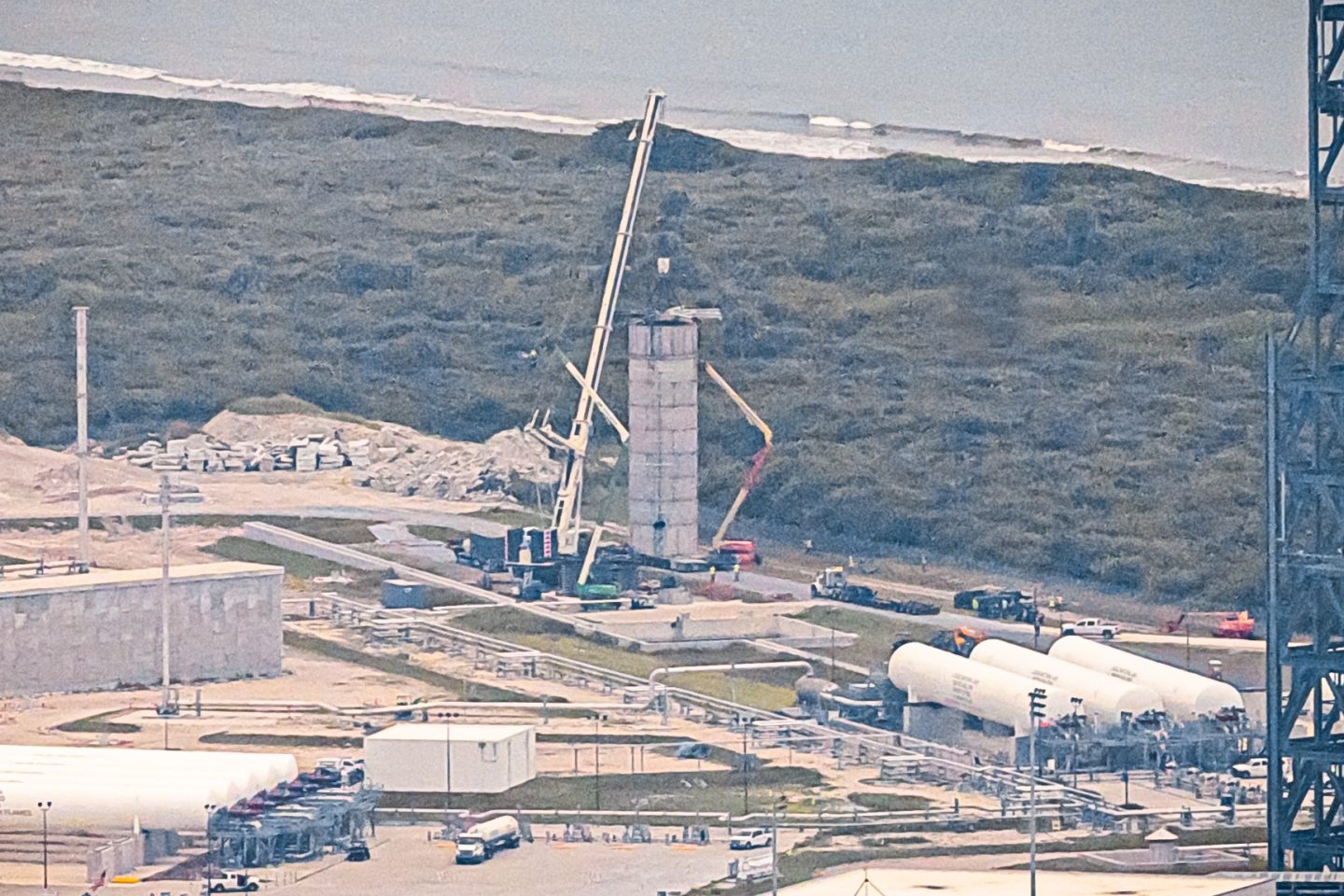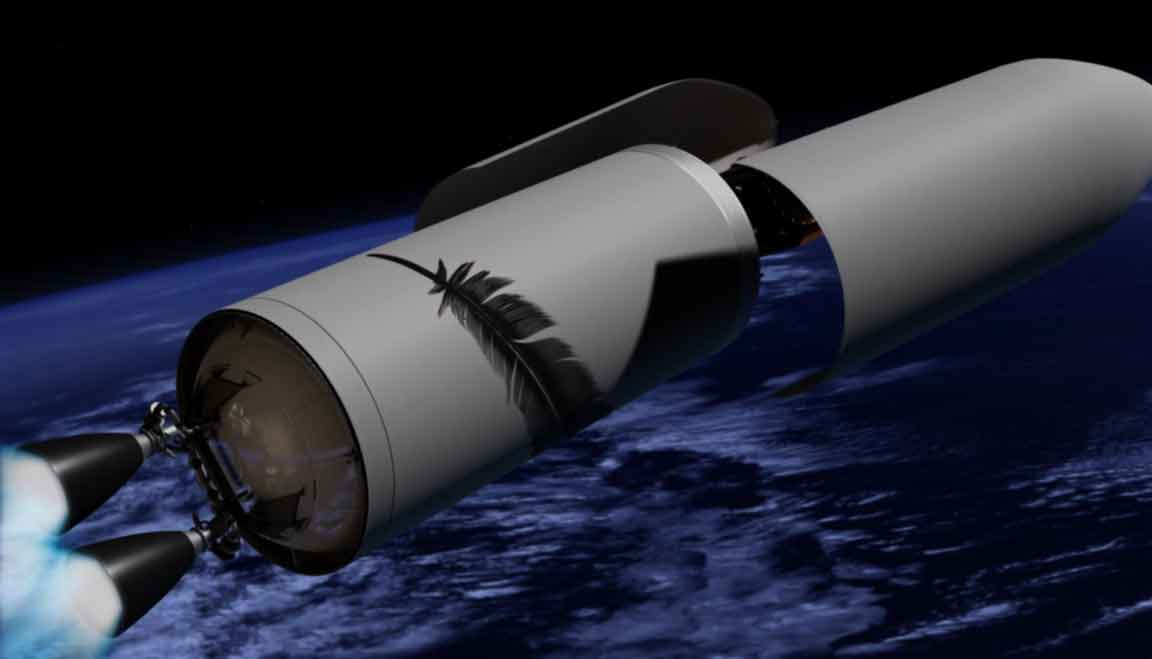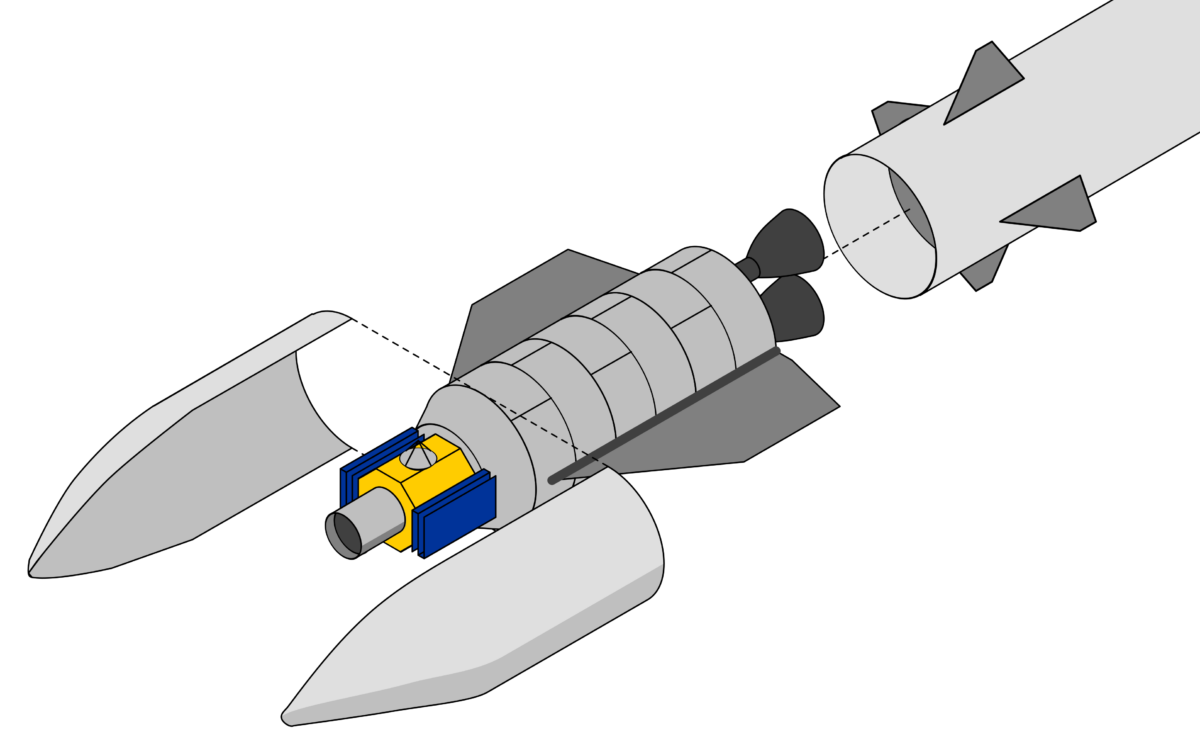In the past week we’ve had some intriguing information and photos about Blue Origin’s shadowy advanced projects division, and their plan for a reusable New Glenn upper stage. Eric Berger’s scoop has caused both celebration (finally, they’re making something other than infographics!) and derision (come back when you’ve hopped the damn tank). But Project Jarvis is more than either – it’s a litmus test for the future of the rest of the launch industry.
After a rocky first half of the year, Blue Origin has emerged with perhaps a single saving grace. Something that stands out from the collapsing engineer morale, the outright embarrassing infographic war and failure to deliver any flight hardware on time. Last Tuesday, a stainless steel test tank was rolled to a test stand on Launch Complex 36. It is the first visible sign of testing for Project Jarvis – an internal skunkworks project to develop a fully reusable upper stage for the upcoming New Glenn heavy lift rocket. The resemblance to the early Starship test tanks is impossible to miss.
Much of the commentary I’ve seen surrounding Jarvis has focused on what it means for Blue Origin’s corporate culture. From the very little we’ve heard, Jarvis is being run out of the Advanced Development Programs division which is almost entirely separate from the rest of the company. In particular, separate from the litigious and hardware-lean management style of Bob Smith and the other “old space” team parachuted in to run the company. There’s been a lot of speculation from Blue fans that the ADP is run almost directly by Bezos, and that he intends it to repopulate the management structure with engineers drawn from it. For those who’ve been despairing at the lack of progress it’s a welcome sight.

However, there are detractors, most of them from the pro-SpaceX camp. They argue that Jarvis intends to do little more than rip off Starship and follow directly behind it. This is compounded by the assumption that Jarvis is drawing engineers away from the rest of Blue where they are sorely needed. After all, we are still wildly behind schedule for both the BE-4 engines and the New Glenn rocket itself. There’s a serious risk that the Jarvis tanks will be ready before they have either engines or a first stage to fly on. There’s also the fear that Bezos is currently scrambling to be seen to be catching up with SpaceX rather than advancing more practical projects. “Concept-rich engineering” may be fun but it’s not a way to run a serious space company.
These views are both fully valid. I want Blue to succeed – their core vision of orbital industry is awesome, they have all the money in the world to throw at the problems and a whole load of highly skilled engineers trying to solve them. At the same time, their track record of delivering projects on time is abysmal, and the recent actions of the management team are unforgivable. Jarvis is certainly a role of the dice for Blue. But it also has a broader implication.
As I see it, Jarvis is the first time a large launch company has acknowledged the implications of Starship. That somewhat unfairly excludes Relativity Space and their Terran R vehicle, but I don’t think it’s unfair to say they exist in a somewhat different sphere. Over the past 5 years, basically every launch provider has made efforts towards a reusable first stage – from ESA’s Themis vehicle to a number of Chinese firms to New Glenn. All of them arrived after Falcon 9 reached full operations and so all are unlikely to make a significant splash. Jarvis is (attempting to) jump the starting pistol in the race to compete in the world of Starship and full reusability. Depending on how it progresses, we will find out two things.
If Jarvis works, it means SpaceX’s technological lead is not unassailable
This is doubly the case given Jarvis’ position as the New Glenn upper stage. Unlike Rocketlab’s Neutron and Relativity’s Terran-R, it is effectively retrofitting full reusability onto a partially reusable rocket. The huge unknown all the way through about Starship has effectively been “how hard is this design, if you don’t have mad goals about Mars”. It’s possible that the head start on Raptors, the TPS, the re-entry characteristics is genuinely 5-10 years – in which case it’s unlikely that anyone will be able to seriously compete with Starship. On the other hand, it’s extremely possible that the challenges of Starship largely stem from Musk’s insane demand for production volume and launch cadence. If New Glenn/Jarvis intends to launch with a one week turnaround rather than 1 hour, perhaps many of the roadblocks can be removed. Regardless, simply by virtue of being the fastest follower, Blue Origin will be the ones who determine the size of the lead they must close.
If Jarvis is financially viable compared to Starship, it means that other providers can survive
The eventual price of launch on Starship is unknown. Musk wants tens of dollars per kilogram, which is patently crazy – I believe those numbers are based on airline operating numbers and an orbital launch system is enormously more complicated than a fleet of planes. But even before these unknowns we can say with some certainty that Starship is going to be cheap as chips. It’s probably competitive with Falcon 9 with a disposable upper stage and even 5 reuses of the orbital vehicle will drop costs further.
If New Glenn/Jarvis can be price-comparable with Starship it will survive. It doesn’t necessarily have to be cheaper – there’s certainly room in the market for a non-SpaceX cheap launch, not least from competitors like Project Kuiper. It just has to be in the same ballpark. But if Starship’s operational model of enormous volume, subsidised by Starlink and Mars launches, turns out to be substantially cheaper than Jarvis, then the rest of the market is screwed. The only possible competition will either be more advanced than Starship or a direct ripoff. That leaves very little for the current players to do and very little income to do it with.
This is why I’m so interested in the outcome of Jarvis. It’s more than the last gasp of a doomed company, or the beginning of a rebirth. It’s a peek into the entire future of the launch industry, a litmus test for how it’ll handle one company trying to work 50 years ahead of market trends. If Jarvis succeeds we will doubtless see copycats and imitators but at least they’ll be genuinely competing for market share with SpaceX. If it fails, it could be the harbinger of doom for many other companies big and small. Only time and launch will tell, and I have no doubt that the managers behind Jarvis appreciate the importance of their task. At least, I hope they do – the window for their survival is closing fast.


4 replies on “Why Project Jarvis is a really big deal”
I disagree that airline like operating numbers are required to bring the cost per kg down to sub $50. I made a spreadsheet with formulas so that I could play with the numbers. The biggest factor was amortizing the R&D if that cost was $2B, it took a lot of flights to absorb. Having a small fleet flying once a week, with say 3 orbital ships per booster, you can get sub $100 in a year, and sub $50 in two or so. Big big big problem is finding the payloads.
As I see it, there’s a number of factors that affect the per-launch or per-kg cost of a vehicle:
– R&D and infrastructure cost, amortized over the number of launches. This includes the cost of actually setting up the factories and launch sites which for Starbase is likely considerable.
– Personnel and operations costs, in both technical support and labour for mounting payloads etc. This is what really bit the Shuttle in the ass – they were paying on the order of $1bn/year on the standing army of engineers and technicians regardless of how many launches actually took place.
– Consumables and logistics costs, which are roughly fixed per-launch
Starship is aiming to have an extreme launch cadence which (should) bring the per-launch costs of infrastructure and operations down. But that’s balanced by the hugely increased cost of building and tooling a production line for vehicles on a scale comparable to small aircraft, rather than cargo ships. If the cadence drops for whatever reason they’ll have a lot more costs to cover versus a company that has only ever aimed to launch a few times a month.
I too am concerned about the effects that the development of starship may have on the market especially if the commercial policy of SpaceX remains unchanged. In fact, launch prices have remained constant over the past five years despite the enormous progress made by the Falcon. This is because SpaceX is not actually interested in commercial launches, as it collects a lot more from government contracts and private investors through Starlink (I haven’t done the calculation but maybe it’s 20 billion in the last 2-3 years). The unchanged launch prices are damaging the entire space sector which has no economic advantage from reusability, but allows SpaceX to dominate the satellite internet market. [OneWeb went bankrupt after Musk pointed out that he didn’t launch with Starlink’s costs (impossible for everyone else). Compared to a few decades ago, a housing module (axiom pays 55 million) costs less than a Crew Dragon launch.]
This SpaceX commercial policy is keeping competitors alive, but by no means (just see the reduction in ULA employees). The paradox is that for a geostationary satellite it is more convenient to use an Ariane 6 (45 million) than a Falcon 9 (52 million). Another paradox is that ArianeSpace made more commercial launches than SpaceX in 2021.
No one can say if with Starship the trade policy will change or if the prices will remain high. (In any case, China will invest heavily in the sector.) These are some scenarios, the uncertainty is so high that I don’t know if any of them are likely.
Scenario 1
[If things don’t change it might cost NASA more to send an astronaut to the Moon than it has SpaceX to send an employee to Mars.] In this scenario, launch prices remain constant (or slightly decreasing) for over a decade, even if a competitor arrives to replicate starship will have to keep prices high to recover the investments made
Scenario 1Bis
No Starship clone arrives in the West (the advantage over competitors is too high) in the long run, the development of launchers stops because the focus is Mars … without stimuli SpaceX slowly transforms into Boeing. In x years China surpasses SpaceX
Scenario 1 Ter
Antitrust intervenes and creates two new autonomous companies from SpaceX: the engine department and the reusability department. Quickly in America (and perhaps in Europe) many clones can arise and development explodes. The development in the launcher sector is increasing. SpaceX has secured the Martian city project thanks to Starlink, the rest of the sector has much cheaper launch prices and consequently the demand for launches increases exponentially
Scenario 2
SpaceX changes commercial policy, all competitors are out of business. This forces the governments of Europe to regain strategic parity to maintain autonomous access to space (and perhaps the US government to fund a competitor).
A potential much bigger market might be point to point transport for human transport. And an SSTO HTHL with a hybrid engine would sweep up that market compared to Starship. Other technologies like an aerospike could also transform the launch market.
There’s plenty of space for those who will innovate, so don’t think it could ever only only be SpaceX in the future. Companies that have gotten fat and/or are too slow, expensive or which lack an innovative culture will fail and others will take their place.